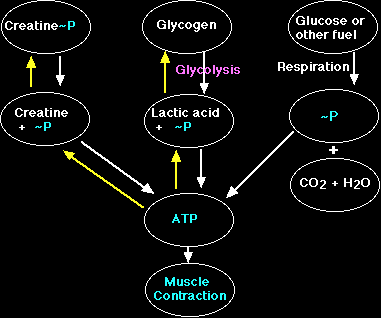Creatine Facts
Creatine is the most
popular and commonly used sports supplement available today. There are numerous
studies backed by anecdotal evidence that support the efficacy of creatine
supplementation. For the majority of the population, including both elite
athletes and untrained individuals,
creatine
supplementation increases fat free mass and improves anaerobic and possibly
aerobic performance. While the effectiveness of creatine is well known, the most
effective way to take creatine is not known. In order to design an "optimal"
cycle for creatine, a number of factors must be considered.
What Is Creatine?
A French scientist discovered creatine in 1835.
Creatine is a natural constituent of meat, mainly found in red meat. Creatine is
manufactured naturally in the body from the amino acids glycine, arginine, and methionine. This process takes place in the kidneys, liver, and pancreas.
Approximately 40% of the body's creatine stores are free creatine (Cr), while
the remaining 60% is stored in form of creatine phosphate (CP). The typical male
adult processes 2 grams of creatine per day, and replaces that amount through
dietary intake and fabrication within the body.

A breakdown of creatine.
Creatine is used for the resynthesis of ATP. ATP,
or adenosine triphosphate, is the "power" that drives muscular energetics. When
a muscle is required to contract, the bonds in the ATP molecule are split,
yielding ADP (adenosine-diphosphate). The energy released by breaking this bond
powers the contraction of the muscle. When ATP is depleted within the cell, the
cell can no longer contract. There are several methods by which the body
rebuilds ATP. The fastest method, without oxygen, is through CP. Creatine
phosphate is "split" to yield the phosphate portion of the molecule. This
phosphate portion bonds to the ADP, turning it back to ATP. Once CP stores
within the cell are depleted, the body must use other methods to replenish ATP.
Supplementation with creatine increases Cr and CP
within the muscle, allowing further capacity to regenerate ATP. In other words,
the creatine enhances the ability of the muscle to maintain power output during
brief periods of high-intensity exercise. The periods are brief because the
ability of a cell to store CP is limited, therefore the body will quickly move
to other methods of replenishing ATP.
The majority of studies regarding creatine
supplementation have used creatine monohydrate, the form of creatine bound to a
water molecule. Some studies suggest that the combination of creatine and
carbohydrate will enhance absorption or "uptake" of creatine. Science shows that creatine is unstable in liquid form, meaning that serum or liquid delivery
systems are currently not supported by scientific literature.
The creatine rapidly degrades to creatinine,
which is not useable by the body. There is very little support for the notion
that creatine in any type of mixture, including an effervescent mixture, is
absorbed more efficiently by the body. A company known as Albion Laboratories,
Inc. claims to have found an effective delivery mechanism by chelating creatine
to magnesium (a chelate is an organic compound that is typically absorbed more
readily by the body than individual elements).
What Is The Most Effective
Creatine Dose?
Effective doses will be examined later in this
article. Current studies tend to follow a very standard protocol:
20 g / d for 5 - 7 days ("loading phase")
5 g / d for remainder of cycle ("maintenance
phase")
A more customized approach is to determine
dose based on mass. A common formula is:
0.3 g / kg / d for 5 - 7 days
0.03 g / kg / d for remainder of cycle
Thus, an individual weighing two-hundred (200)
pounds would require 200 lb * (1 lb / 2.2 kg) * 0.3 g = 27 grams per day for the
loading phase, then 2.7 grams per day for the maintenance phase. Calculate this
for yourself below. It is known that creatine supplementation increases
intramuscular creatine stores. To base creatine dose on total weight, therefore,
seems inaccurate. A 200 lb individual with 20% body fat would have less lean
mass than a 200 lb individual with 8% body fat.
Calculate Your Creatine Intake
- Based On Total Bodyweight
|

